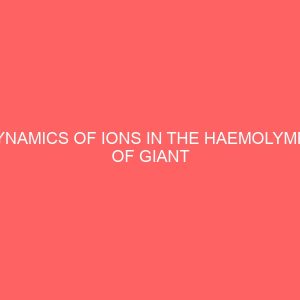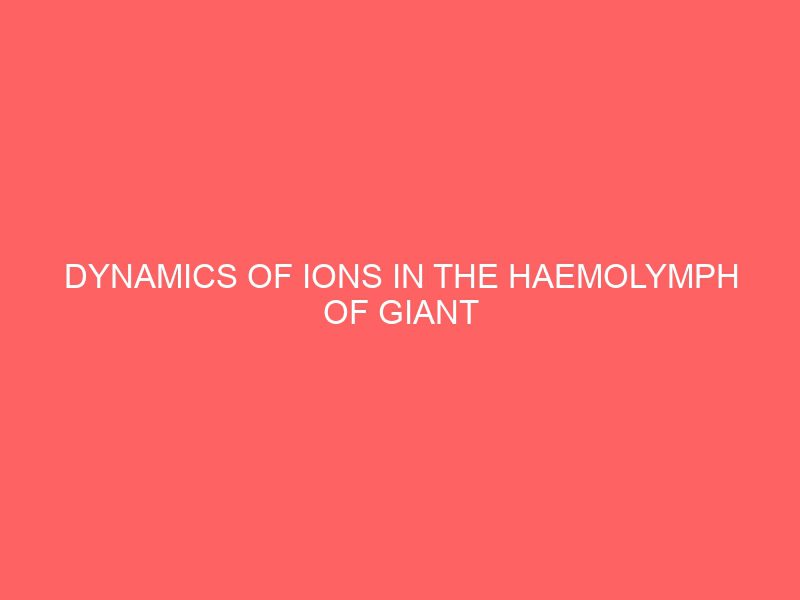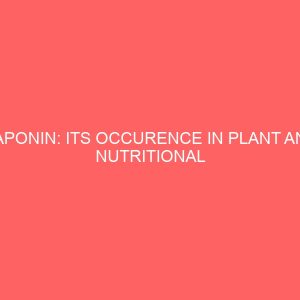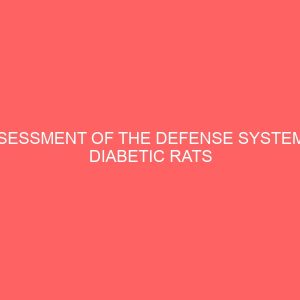Description
ABSTRACT
This experiment was conducted to study the dynamics of ions in the haemolymph of Giant African land snails (Archachatina marginata) during fasting. Fourty Archachatina marginata were purchased and using a completely randomized design (CRD) they were arranged into four different treatments. Haemolymph was collected randomly from three samples within each treatment and the samples were analyzed for electrolytes which include sodium, bicarbonates, chlorides, creatinine, calcium, phosphate and potassium. For sodium there was significant difference in its concentration in the haemolymph from week 3 to week 6 (P<0.05) with the lowest concentration in week 6 and the highest in week 3. For bicarbonate significant difference (P<0.05) in the concentration of the haemolymph was only noticed from week 0 to week 3 with the lowest concentration found in week 9 and the highest in week 0. There was significant difference (P<0.05) from week 0 to week 9 in the concentration of haemolymph chloride with the lowest concentration found in week 6 and the highest in week 3. There was no significant difference (P>0.05) in the concentration of creatinine through the 9 weeks of the study. Calcium concentration had no significant difference (P>0.05) from week 0 to week 3, the lowest concentration was found in week 6 and the highest week 3. Phosphates concentration had no significant difference (P>0.05) from week 0 to week 9 with the lowest concentration found in week 9 and the highest in week 6. Fasting had no significant difference (P>0.05) on the concentration of potassium through the 9 weeks of the experiment the lowest concentration was found in week 9 and the highest week 0. From this study fasting had no effect on the phosphate and creatinine concentration of the haemolymph of Archachatina marginata, but with effect on sodium, bicarbonate, chloride, potassium and calcium.
.
TABLE OF CONTENT
Title———-i
Abstract———ii
Acknowledgement——-iii
Certification——–v
Dedication——–vi
Table of Content——-vii
List of Tables——–ix
List of Figures——–x
CHAPTER ONE
1.0Introduction——-1
1.1Justification of study——2
1.2Objective of the study——4
CHAPTER TWO
Haemolymph——-6
Sodium——-6
Potassium——-7
Bicarbonate——-8
Chloride——-8
Serum creatinine——8
Calcium——-9
Inorganic phosphate——9
CHAPTER THREE
Materials and Methods—–10
3.1Experimental site, animals and methods—-10
3.2Collection of haemolymph——11
3.3Chemical analysis——-11
3.4Statistical analysis——-12
CHAPTER FOUR
4.0 Results———13
CHAPTER FIVE
5.0 Discussion——–28
CHAPTER SIX
6.0Conclusion——- -30
6.1Recommendation——-30
Reference——–31
LIST OF TABLES
Table 1: Blood test range for some animals—-5
Table 2: Variation of ions in the haemolymph of giant African land snail (Archachatina marginata) during a nine week fasting period-27
LIST OF FIGURES
Figure 1: Graph showing changes in the haemolymph sodium concentration of Archachatina marginata after 9 weeks of fasting.—-14
Figure 2: Graph showing changes in the haemolymph bicarbonate concentration of Archachatina marginata after 9weeks of fasting.—-16
Figure 3: Graph showing the changes in the haemolymph chloride concentration of Archachatina marginata after 9 weeks of fasting.—18
Figure 4: Graph showing the changes in the haemolymph creatinine concentration of Archachatina marginata after 9 weeks of fasting.—20
Figure 5: Graph showing the changes in the haemolymph calcium concentration of Archachatina marginata after 9 weeks of fasting.—22
Figure 6: Graph showing changes in the haemolymph phosphates concentration of Archachatina marginata after 9 weeks of fasting.—24
Figure 7: Graph showing changes in the haemolymph potassium concentration of Archachatina marginata after 9 weeks of fasting.—26
CHAPTER ONE
1.0INTRODUCTION
Snail is the common name that is applied most often to land snails, terrestrial pulmonate gastropod mollusks. However the common name snail is also applied to most of the members of the molluscan class gastropoda that have coiled shell that is large enough for the animal to retract completely into (Wikipedia.com. 2012). Snails are invertebrates which mean that they lack a backbone. They belong to a large and highly diverse group of invertebrates known as the Phylum mollusca (also known more commonly as ‘mollusks’). The Phylum mollusca include slugs, clams, oysters, mussels, squids, octopuses and nautiluses, in addition to snails (About.com. 2012).
They belong to the class Gastropoda. Gastropoda are a major part of the phylum mollusca and are the most highly diversified class in the phylum. Snails belong to the order stylommatophora (Fryda et al, 2005). Snails are terrestrial and marine shell-bearing animals of approximately 80,000-100,000 species of the phylum Mollusca (Cooper and Knowler, 1991). They are the second largest phylum in the animal kingdom. Europe and Africa are two important regions notable for snail production and consumption involving mainly the snail families Helicidae and Achatinidae, respectively. However, the giant African land snails Achatina achatina and Archachatina marginata are the most popular edible snails in the West African high forest zones (Ogunsami et al., 2003, Cobinah et. al, 2003).
During dry spells free-living snails withdraw into their shells and conserve water by sealing the shell opening with an epiphragm and aestivate by reducing mobility reproductive behaviour and growth. Water loss is further retarded by the use of discontinuous breathing pattern; the pneumostome opens intermittently to allow a rapid exchange of CO and O (Hermes-lima et. al, 1998). When humidity falls below 75% (as witnessed during the dry season: October to Mid-March in West Africa), A. achatina becomes inactive and seals itself into its shell with a white calcareous layer and aestivates in order to prevent loss of water from the body (Omoyakhi, 2007). A. marginata were observed to form epiphragm more readily and replace them more frequently than A. achatina (Omoyakhi, 2007). Snails are said to survive many months without food and water under aestivation (Akinnusi, 1998). The aestivated snails draw on their reserve of fat and glycogen at much reduced rate, which implies an imminent reduction in weight and loss of valuable growing time as growth during aestivation is said to reduce.
The success of gastropod molluscs in terrestrial habitats has been due to various structural, physiological and behavioural specializations (Riddle, 1983). One specialization that is well developed among the pulmonate land snails is the capacity to enter the dormant state of aestivation during periods of hot and dry environmental conditions (Rees and Hand, 1993). Snails can be found in a very wide range of environments, including ditches, deserts, and the abyssal depths of the sea. Although many people are familiar with terrestrial snails, they are in the minority. Several species of the genus Achatina and related genera are known as giant African land snails (GALS); some grow to 15 in (38 cm) from snout to tail, and weigh 1 kg (Frederick, 2010).
1.1 Justification of Study
Haemolymph is the blood analogue found in all arthropods and most molluscs which have an open circulatory system (Ebroadcast.com 2012). It is composed of water, inorganic salts (mostly Na, Cl, K, Mg and Ca) and organic compounds (mostly carbohydrates, proteins and lipids). Muscular movements by the animal during locomotion can facilitate haemolymph movement, but diverting flow from one area to another is limited (Harris, 2000). Responses to high or low temperatures in the snail induce aestivation and hibernation.
The haemolymph is an important medium for the transport of nutrients to and wastes from various organs of the snail. Aestivation, being a structural, physiological and behavioural response to desiccation, probably plays a role in the dynamics of haemolymph changes in land snails as haemolymph ionic concentration is said to show seasonal fluctuations, strongly influenced by hydration, feeding and acid/base balance (Langley, 2004). There are limits to the duration of aestivation that can be tolerated by land snails and mortality eventually increases as aestivation is prolonged (Rees and Hand, 1993). Comprehensive values of haemolymph ionic parameters for the giant African land snails are now popularly reported in literature but none for fasting snails. Reference range values for haemolymph ionic parameters from non-aestivating, aestivating and fasting Archachatina marginata could therefore be useful for assessment of physiologic and pathologic alterations in wild as well as captive snails and establish their possible application in the evaluation of health and disease status. The information may also be useful in domestication, management and bio-conservation initiatives involving this species.
1.2Objective of the study
This research therefore studied dynamics of the haemolymph ionic composition of the Giant African land snail during fasting.







